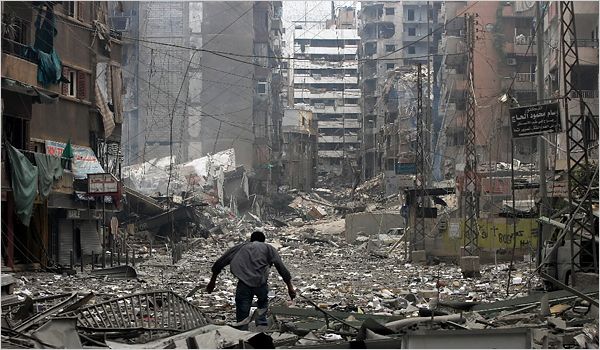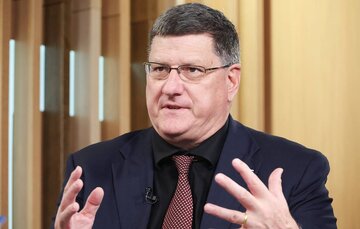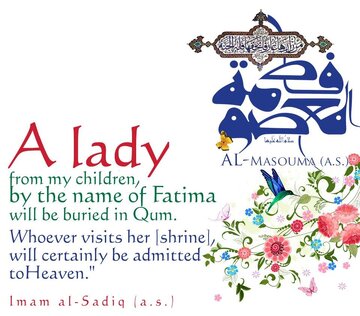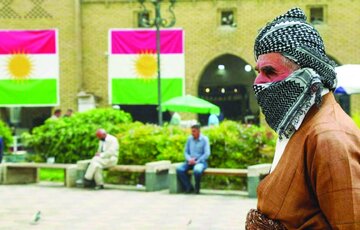AhlulBayt News Agency (ABNA): On 8 March 1985, a huge explosion took place in Beirut. The target of the terrorist attack was Ayatollah seyyed MuhammadHossein Faz Allah. He survived the attack but the explosion caused death of 105 people and left 275 poeple wounded. Robert McFarlane, US security advisor and a high ranked CIA agent, believes that this failed attempt discredited the United States. William Casey, then CIA chief executive, managed the operation himself. Later, it was revealed that he had the financial support of Al-e-Saud.
Seyyed MuhammadHossein, Son of seyyed Abd-al-Raoof, Son of seyyed Najib-al-Din, Son of seyyed Mohyi-al-Din..., whom their ancestor was Imam Hassan (greetings to him), was born on 17 November 1935 in Najaf. His father had immigrated to Najaf when he was a teenager, to continue his religous education. Seyyed MuhammadHossein was 9 when he fist attended his father's class and at the age of 16, he started to learn Bahath-e-Kharij learned from Ayatollah Lankarani, Rouhani, Bojnourdi, Khoyi, Hakim, Shahroudi, and....
His mother was Haji Raoofeh Bezzi. His wife was Seyyedeh Nejah Nour-al-Din, daughter of Ayatollah seyyed Nour-al-Din and they had 12 children. The most famous ones are Hojat-al-Islam seyyed Ali & seyyed Jafar Fazl Allah.
He started teaching a little while after he entered Hawza. Soon he turned into a great master of religous courses, and had many students from all over the world, such as Lebenon, Iraq, Bahrain and... The books he taught were Kefaya, Rasail, Makasib and Madarik-al-Ahkam. He loved to study and learn from the ideas and theories of philosophers, and since he was ten, he read publications and magazines sent from Lebenon and Egypt, namely al-Mosavvar and al-Makatib.
At the age of 11, he and some of his fellows, like his cousin the martyr seyyed MuhammadMahdi Hakim, published "al-Adab". In 1960, they published "al-Azva-al-Islami". On the first year, the first headline with the title "Our Mission" was written by martyr Sadr and Fazl Allah wrote the second one with the title "Our Word".
In 1966,he returned to his home country. He was the agent of Ayatollah Hakim and Khoyi in Lebenon and from the very first days he started to establish religous and cultural services. He established Hawza and taught in Beirut and Damascus till the end of his life. He adored studying, teaching and learning and never gave up on his passion.
Soon he found his place among the Lebonese with various beliefs. Followers of various religons and tribes respected him. It's hard to mention even a few of his social and economic endevears in this article. He established many religous schools, Hawzas, charity institutions, hospitals, hotels, gas stations, libraries, research centres and... He cared for the orphans and established institutions to take care of them.
He had many great students, namely seyyed Abbas Mousavi, Sheikh Naeim Ghasim, seyyed Hassan Nouri and...
He had a great role in modernization of the combatant Islam and forming the Hizbollah. Some sources mention his name as the spiritual father of Hizbollah. He was the first Marja who allowed martydom operations against Zionists. There were four attemps to murder him, one of them mentioned above. It happened two years after the 23 October 1983 incident, which a French-American military base in Beirut had been attacked and 241 American troopers and 74 French paratroopers were killed. The humiliated occupiers left Lebonon in a short time after the attack. The American and European intelligence services decided to eliminate the great scholar of Lebonon. They were aware of his efforts to build up a educated and trained generation, so they planned the Bir-al-Abd felony.
A truck carrying 200 kilograms of dinamit exploded after the prayers of Jomah, on Friday, 8 March 1958. Soon after Fazl Allah left the mosque, a terrorist called Hassan Salman prepared themselves to blow up the truck with a remote control from the top of a ten storeybuilding. But fortunately a woman called Zeinab-al-Shami had stopped his car to ask him a religous question ,so he survived the explosion. The explosion caused the death of 105 men, women and children and and got 275 people injured. Most of them were leaving the mosque after the prayers. Two bulidings and a cinema was destroyed. Some of the gurdians of Seyyed were also murdered. After the incident, people built up a memorial there, which is marked "Made in USA".
The order of terrorist attack was given by the United States National Security Council and confirmed by Reagan.
He continued his path of knowledge and Jihad. After Imam Khomeni passed away, he declared himself as Marja and many high ranked Shia scholars confirmed his creditibility. He wrote more than 100 books about Islamic regulation, Quran, Ahl-ol-Bait, Society, Poetry, Politics and.... He supported Imam Khomeini and Islamic Revolution and considered it as his duty. He had different views about the women's rights as a Marja, he banned Tatbir and declared People of the Book purifed. He believed every human being is pure, even the nonbelievers.
He believed in the council of jurists in the Guardianship of the Islamic Jurist, and that the jurist walks in the path of justice, thinking of the benefits of the people.
About the incident of Bab-al-Zahra (greetings to her) he noted that there is no reason to deny what happened there, setting the door on fire, slapping and... He critisized the scholars who had denied the aspects of the incident.
He met philosophers such as Noam Chamsky, Mesbah Yazdi and... He always impressed his addressee with his reseanings.
In his opinion, the text and the reality are two main sources of political thought. The text inspires the values. The mobility of the text is tested in its flexibility and adaptability through time. He believed that the desired structure due to the texts, is the one with brings justice and freedom for people. In the last years of his life, he was misunderstood and critisized by some scholars inside and outside Iran.
Ayatollah Khoyi, left a note announcing that he was his representative: "His hand is my hand, His words are my words". With the warrant of Ayatollah Khamenei, he was chosen as a member of Alh-al-Bayt Assembly supreme council.
The words of Marjas and Shia scholars after he passed away are very contemplative. A board from Iran attended his funeral in Beirut, including gentlemen Jannati, Akhtari, Taskhiri, Borujerdi and.... Then they met seyyed Hassan Nasrollah. He blamed some scholars for mistreating seyyed MuhammadHossein Faz Allah and not offering condolences for his loss.
Seyyed MuhammadHossein, Son of seyyed Abd-al-Raoof, Son of seyyed Najib-al-Din, Son of seyyed Mohyi-al-Din..., whom their ancestor was Imam Hassan (greetings to him), was born on 17 November 1935 in Najaf. His father had immigrated to Najaf when he was a teenager, to continue his religous education. Seyyed MuhammadHossein was 9 when he fist attended his father's class and at the age of 16, he started to learn Bahath-e-Kharij learned from Ayatollah Lankarani, Rouhani, Bojnourdi, Khoyi, Hakim, Shahroudi, and....
His mother was Haji Raoofeh Bezzi. His wife was Seyyedeh Nejah Nour-al-Din, daughter of Ayatollah seyyed Nour-al-Din and they had 12 children. The most famous ones are Hojat-al-Islam seyyed Ali & seyyed Jafar Fazl Allah.
He started teaching a little while after he entered Hawza. Soon he turned into a great master of religous courses, and had many students from all over the world, such as Lebenon, Iraq, Bahrain and... The books he taught were Kefaya, Rasail, Makasib and Madarik-al-Ahkam. He loved to study and learn from the ideas and theories of philosophers, and since he was ten, he read publications and magazines sent from Lebenon and Egypt, namely al-Mosavvar and al-Makatib.
At the age of 11, he and some of his fellows, like his cousin the martyr seyyed MuhammadMahdi Hakim, published "al-Adab". In 1960, they published "al-Azva-al-Islami". On the first year, the first headline with the title "Our Mission" was written by martyr Sadr and Fazl Allah wrote the second one with the title "Our Word".
In 1966,he returned to his home country. He was the agent of Ayatollah Hakim and Khoyi in Lebenon and from the very first days he started to establish religous and cultural services. He established Hawza and taught in Beirut and Damascus till the end of his life. He adored studying, teaching and learning and never gave up on his passion.
Soon he found his place among the Lebonese with various beliefs. Followers of various religons and tribes respected him. It's hard to mention even a few of his social and economic endevears in this article. He established many religous schools, Hawzas, charity institutions, hospitals, hotels, gas stations, libraries, research centres and... He cared for the orphans and established institutions to take care of them.
He had many great students, namely seyyed Abbas Mousavi, Sheikh Naeim Ghasim, seyyed Hassan Nouri and...
He had a great role in modernization of the combatant Islam and forming the Hizbollah. Some sources mention his name as the spiritual father of Hizbollah. He was the first Marja who allowed martydom operations against Zionists. There were four attemps to murder him, one of them mentioned above. It happened two years after the 23 October 1983 incident, which a French-American military base in Beirut had been attacked and 241 American troopers and 74 French paratroopers were killed. The humiliated occupiers left Lebonon in a short time after the attack. The American and European intelligence services decided to eliminate the great scholar of Lebonon. They were aware of his efforts to build up a educated and trained generation, so they planned the Bir-al-Abd felony.
A truck carrying 200 kilograms of dinamit exploded after the prayers of Jomah, on Friday, 8 March 1958. Soon after Fazl Allah left the mosque, a terrorist called Hassan Salman prepared themselves to blow up the truck with a remote control from the top of a ten storeybuilding. But fortunately a woman called Zeinab-al-Shami had stopped his car to ask him a religous question ,so he survived the explosion. The explosion caused the death of 105 men, women and children and and got 275 people injured. Most of them were leaving the mosque after the prayers. Two bulidings and a cinema was destroyed. Some of the gurdians of Seyyed were also murdered. After the incident, people built up a memorial there, which is marked "Made in USA".
The order of terrorist attack was given by the United States National Security Council and confirmed by Reagan.
He continued his path of knowledge and Jihad. After Imam Khomeni passed away, he declared himself as Marja and many high ranked Shia scholars confirmed his creditibility. He wrote more than 100 books about Islamic regulation, Quran, Ahl-ol-Bait, Society, Poetry, Politics and.... He supported Imam Khomeini and Islamic Revolution and considered it as his duty. He had different views about the women's rights as a Marja, he banned Tatbir and declared People of the Book purifed. He believed every human being is pure, even the nonbelievers.
He believed in the council of jurists in the Guardianship of the Islamic Jurist, and that the jurist walks in the path of justice, thinking of the benefits of the people.
About the incident of Bab-al-Zahra (greetings to her) he noted that there is no reason to deny what happened there, setting the door on fire, slapping and... He critisized the scholars who had denied the aspects of the incident.
He met philosophers such as Noam Chamsky, Mesbah Yazdi and... He always impressed his addressee with his reseanings.
In his opinion, the text and the reality are two main sources of political thought. The text inspires the values. The mobility of the text is tested in its flexibility and adaptability through time. He believed that the desired structure due to the texts, is the one with brings justice and freedom for people. In the last years of his life, he was misunderstood and critisized by some scholars inside and outside Iran.
Ayatollah Khoyi, left a note announcing that he was his representative: "His hand is my hand, His words are my words". With the warrant of Ayatollah Khamenei, he was chosen as a member of Alh-al-Bayt Assembly supreme council.
The words of Marjas and Shia scholars after he passed away are very contemplative. A board from Iran attended his funeral in Beirut, including gentlemen Jannati, Akhtari, Taskhiri, Borujerdi and.... Then they met seyyed Hassan Nasrollah. He blamed some scholars for mistreating seyyed MuhammadHossein Faz Allah and not offering condolences for his loss.





